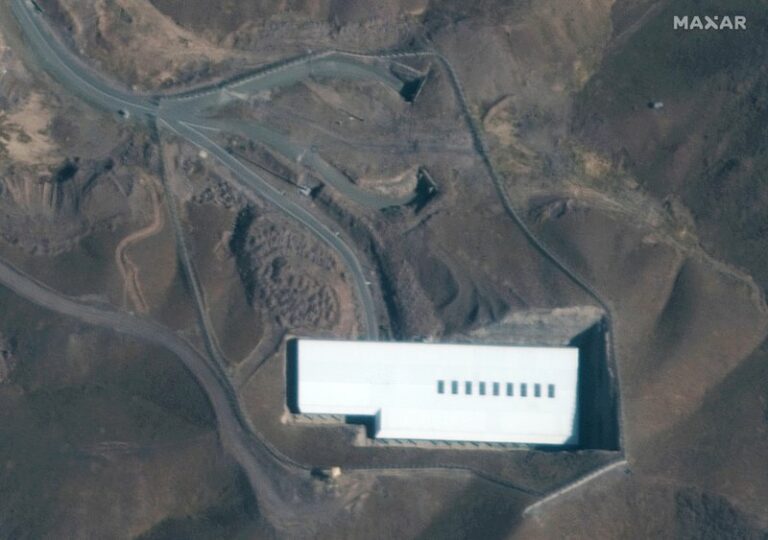Ten years ago while flanked by the leaders of Britain and France, then-President Barack Obama revealed to the world that Iran had built a “covert uranium enrichment facility” amid tensions with the Islamic Republic over its nuclear program.
A decade later, Iran’s Fordo facility is back in the news as Iran prepared Wednesday to inject uranium gas into the more than 1,000 centrifuges there to pressure the world after President Donald Trump withdrew the U.S. from Tehran’s nuclear deal.
The resumption of nuclear activity at Fordo pushes the risk of a wider confrontation involving Iran even higher after months of attacks across the Middle East that the U.S. blames on Tehran. Israel, which has carried out pre-emptive airstrikes on its adversaries’ nuclear programs in the past, also is repeating a warning that it will not allow Iran to have atomic weapons.
Tehran, which maintains its program is peaceful, is gambling that its own maximum pressure campaign will be enough to push Europe to offer it a way to sell Iranian crude oil abroad despite U.S. sanctions
Activity at Fordo, just north of the Shiite holy city of Qom, remains a major concern for nuclear nonproliferation experts. Buried under a mountain and protected by anti-aircraft batteries, Fordo appears designed to withstand airstrikes. Its construction began at least in 2007, according to the International Atomic Energy Agency, although Iran only informed the U.N. nuclear watchdog about the facility in 2009.
“As a result of the augmentation of the threats of military attacks against Iran, the Islamic Republic of Iran decided to establish contingency centers for various organizations and activities,” Iran wrote in a letter to the IAEA.
Satellite images, however, suggest construction at the Fordo site as early as between 2002 and 2004, the IAEA said. In August 2002, Western intelligence services and an Iranian opposition group had revealed another covert nuclear site at the central city of Natanz. Iran also “carried out activities relevant to the development of a nuclear explosive device” in a “structured program” through the end of 2003, the IAEA has said.
While Natanz is large enough for industrial-scale enrichment, Fordo is smaller and can hold only 3,000 centrifuges. That led analysts to suspect Fordo could be used as a facility to divert and rapidly enrich low-grade uranium, although the highest reported enrichment reached there went to 20%.
“The size and configuration of this facility is inconsistent with a peaceful program,” Obama said at a 2009 Group of 20 meeting held in Pittsburgh in announcing the facility to the world.
Iran’s 2015 nuclear deal with world powers saw the country agree to stop enrichment at Fordo and convert it to a research facility. However, President Hassan Rouhani’s announcement Tuesday that uranium gas would be injected into centrifuges there again makes it an active nuclear site.
The IAEA continues to monitor Iran’s nuclear program through surveillance cameras and site visits. Tehran also insists it will keep enriching up to 4.5%, which remains far below weapons-grade levels of 90%.
Resuming work at Fordo has worried Israel, Iran’s regional archenemy.
“We will never let Iran develop nuclear weapons,” Israeli Prime Minister Benjamin Netanyahu said in a speech Tuesday night. “This is not only for our security and our future; it’s for the future of the Middle East and the world.”
Israel, which has its own undeclared nuclear weapons program, has struck first in the past to stop its enemies from obtaining atomic weapons. In 1981, Israeli warplanes bombed a nuclear reactor being built by Irai dictator Saddam Hussein. An Israeli airstrike similarly destroyed a secret Syrian nuclear reactor in 2007.
The Obama administration convinced Israel before the 2015 nuclear deal to hold off on conducting such a strike on Iran. It remains unclear how Trump would respond to such an Israeli plan, though he has roundly supported Netanyahu in the past.
Any potential strike also faces the challenge of actually reaching the facility. Fordo sits an estimated 80 meters (260 feet) under rock and soil. That would require a weapon like a U.S. “bunker-buster” bomb, a 30,000-pound explosive known as the Massive Ordnance Penetrator. Israel is not known to have a similarly powerful conventional weapon.
There’s also the possibility the U.S. and Israel could reach the facility another way. The Stuxnet computer virus, widely believed to be a joint U.S.-Israeli creation, caused thousands of Iranian centrifuges to destroy themselves in the late 2000s.
The one route that doesn’t seem likely at the moment to resolve the growing crisis over Fordo is diplomacy. Europe so far has been unable to offer Iran any way around U.S. sanctions, despite a planned trade mechanism and a floated French offer of a $15 billion line of credit. Meanwhile, the Trump administration continues its sanctions campaign against Tehran, which on Monday saw it add members of Supreme Leader Ayatollah Ali Khamenei’s inner circle. Iran already says it will take further steps away from the deal in January.
“The decision to expand nuclear activities at Fordo is Iran’s most serious violation of the nuclear deal to date,” the Eurasia Group said. ”“If it does not sense meaningful pushback from the international community, there is little reason to doubt it will continue to push the envelope further in January.”
(AP)











